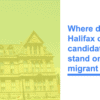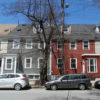
SEDABOOKTOOK (Guysborough) – While electronic devices are enabling us to remain at home, to be more sedentary and to shop online, our blood circulation device (our heart) and arguably our body’s main organ (our brain), need us to be mobile. To that truism we add the multiple impacts regarding COVID-19 which require us to be cautious and sensible with our activities and mobility thereby putting us into new-normal lifestyles.
Being social creatures, humans need opportunities to interact safely with others via face-to-face involvements regardless if they occur as activities or only conversations. Our challenges in this necessary limited-contact reality are to seek safe and healthy means via which to be mobile and to stay in contact with others while we adapt to the impacts of COVID- 19 and, sensibly, prepare for the next pandemic.
An activity which is healthy for both the body and brain is to leave our residences and go for a walk thereby assisting both to deal with the demands of living. Taking that suggestion a step further we then need to assess how available and safe are our opportunities to travel by muscle power around our communities. The opportunities for our self-motivation to get up and move without the need to use a motorized vehicle to travel to another location must be provided.
In today’s culture we too often rely on other agencies to provide the facilities for us to gain exercise when such benefits already exist by simply stepping out of our homes. But, to do so we must not be vulnerable to injuries or death by travelling on the shoulders of highways or walking on the roadways’ graveled edges. I firmly believe that safe non-vehicular travel possibilities for all must be reality for residents and visitors as they move around welcoming communities.
Coupled with the physical benefits enabled by sidewalks, the act of getting out of our residences to move also enriches our mental well-being. Such outings give us opportunities to socialize, to have alternative thoughts, to work our bodies and to get some fresh air. The occasion to move around our communities without the many negative possibilities caused by a nearness to traffic is a physical and mental health-enhancing factor that community decision makers need to recognize and work to develop.
I am aware that sidewalks have financial requirements but their provisions for persons’ physical activities and mental health opportunities are natural aids to enable people to assist their levels of fitness thereby reducing their uses of our health-care services.
The findings of Newfoundland Labrador’s Memorial University researcher Asia Holloway regarding her conclusions as a participant in a research paper dealing with the possible health and financial benefits of walking in St. John’s, N.L. as reported by Mark Quinn/CBC is noteworthy. When we adjust the paper’s results to our specific neighbourhoods, it is crystal clear that safe non-vehicular travel is vital for healthy communities.
The research paper, released in August 2020 states: “Physical inactivity is strongly linked to pervasive chronic diseases in N.L., like obesity, heart disease, chronic obstructive pulmonary disease (COPD), diabetes, and mental illness. The health benefits of physical activity are numerous including improving cardiovascular health, improving mental health by reducing anxiety and depression”.
In addition to improved physical and mental benefits, sidewalks enable business and environmental improvements associated with maintained travel routes. Appropriate non-vehicular travel paths in all communities might be a fiscal challenge but as a cliché states: “Where there is a will, there is a way”.
Residents and business owners chose to locate in neighbours for specific reasons. Community dwellers expect to be able to safely roam their regions as do visitors who, like me, enjoy venturing into communities to view where others have chosen to reside and/or to shop. Businesses welcome the availability of community accesses to their establishments thereby improving their services and revenue sources. Property owners appreciate the mobility enhancements in their neighbourhoods for the positive prospects to themselves, their neighbours and visitors.
With the arguably main-street business-destroying influences of big-box stores and the restrictions due to the pandemic, community mobility must be emphasized by our commercial and government decision makers.
The existences of accessible small businesses provide opportunities more numerous than just purchases. Such enterprises enable entrepreneurs to be creative with their business ventures. Their sales’ profits have a greater chance of remaining within that community while enhancing the appeal to others to venture into commercial endeavours. They provide incentives for visitors to travel into regions to have the positive experiences to enjoy what welcoming communities have to offer.
Therein lays my argument for today: maintained non-vehicular sidewalks are vital for healthy, welcoming communities and they are necessary for our mental and physical health. They too are essential for their commercial benefits coupled with the human need to associate with others as we struggle through this pandemic while wearing masks when necessary, maintaining social distancing and washing our hands frequently.
Ray Bates, Guysborough, a former school principal and NS Community College faculty member (Ret’d) has been contributing his opinions to newspapers since 1998.
With a special thanks to our generous donors who make publication of the Nova Scotia Advocate possible.
Subscribe to the Nova Scotia Advocate weekly digest and never miss an article again. It’s free!



